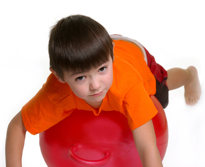The Miracle of Attachment
When I think of my teens as newborns, I can remember swaddling them, gazing into their eyes and being in awe at their miraculous appearance in my life. And I remember getting lots of advice about how much I should hold them, how I should let them “cry it out,” how I shouldn’t rock them to sleep. It was hard to sort it all, so I just went with my gut. My son seemed to need a lot of holding and rocking and my daughter not quite as much.
It wasn’t until they were older that I found out those hours of “gleaming and beaming” with my babies served a very important purpose. That interaction between baby and parent activates a tiny area of the baby’s brain, called the right OFC (=orbitofrontal cortex). This area is responsible for the beginning of emotional control – it helps a baby control their emotional responses to all the sensory information flooding their brain. This ability to control our emotions is the beginning of self-regulation. Self-regulation is a precursor to attention and learning (and one of the things they learn about is movement!). The study of the changes that occur in the baby’s brain with relationship is actually a whole field of study – the neurobiology of attachment.
Children with special needs sometimes have difficulty getting to a place where they can gleam and beam – motor difficulties, sensory processing challenges and pain can all interfere with the ability to participate in this relationship. But if parents can match a baby’s mood and their level of involvement and can follow their lead, then attachment develops. Therapists too can read the cues and follow the child’s lead to facilitate attachment. The relationship between baby and therapist helps baby feel safe enough to take risks when moving their bodies in space.
The bottom line is that relationship wires a baby’s brain. With balanced and consistent interaction, this process sets up a baby’s ability to self-regulate their emotions and builds attention for learning. Now that’s what I call miraculous.
———-
Shelley Mannell PT
HeartSpace Physical Therapy for Children www.heartspacept.com
@heartspacept on Twitter or HeartSpacePT on Facebook
Note: To support the site we make money on some products, product categories and services that we talk about on this website through affiliate relationships with the merchants in question. We get a small commission on sales of those products.That in no way affects our opinions of those products and services.
Related Posts
-
 Moving
by Julia Roberts 24 Jan 2014
Moving
by Julia Roberts 24 Jan 2014 -
Round & Round the Garden…(for core strength)
by Shelley Mannell 15 Mar 2012
-
 Toe Walking: What it is, how to treat it
by Julia Roberts 3 Sep 2014
Toe Walking: What it is, how to treat it
by Julia Roberts 3 Sep 2014 -
 Standing Up
by Shelley Mannell 27 Mar 2014
Standing Up
by Shelley Mannell 27 Mar 2014

